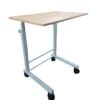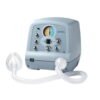Starting From: ₹1,000.00
Request a demo Call 844-844-0648
The Tabletop Pulse Oximeter: Compact, accurate, and portable. Ideal for home or clinical use, it provides quick oxygen saturation readings with advanced features like a plethysmograph and perfusion index indicator. Convenient tabletop design, multiple user memory, and an oxygen level alarm make it a reliable monitoring solution.
SKU: N/A
Category: Other Equipments
Tags: Accurate tabletop oximeter, Bedside pulse oximeter, Clinical pulse oximetry device, Compact tabletop SpO2 monitor, Digital pulse oximeter, Easy-to-read tabletop oximeter, High-precision tabletop oximeter, Home use oximeter, Medical-grade pulse oximeter, Oxygen saturation meter for tabletop, Portable tabletop oximeter, Professional-grade SpO2 monitor, Pulse oximeter for table use, Tabletop oximeter with alarm, Tabletop oxygen saturation monitor, Tabletop pulse oximeter, Tabletop SpO2 monitor, User-friendly pulse oximeter, Wireless tabletop pulse oximeter
Monitor Your Vital Signs with Precision Using the Tabletop Pulse Oximeter.
Keep a close eye on your blood oxygen saturation levels and pulse rate with this advanced tabletop pulse oximeter. Featuring industry-leading sensors and technology, this easy-to-use device provides fast, accurate readings of your SpO2 and pulse rate in seconds.
Key Features:
– Large LED display: The bright LED display clearly shows your blood oxygen saturation and pulse readings, even from across the room.
– Fast, accurate readings: Get SpO2 and pulse readings in just seconds using the built-in sensors. The latest technology provides best-in-class accuracy.
– Non-invasive monitoring: Simply place your finger in the sensor to get instant readings. The pulse oximeter is completely safe, painless and non-invasive.
– Adjustable alarm: Set custom high/low SpO2 and pulse alarms to alert you if your levels go outside the desired range. The alarm can also be disabled when not needed.
– Rugged, durable design: The high-quality pulse oximeter is built to handle repeated daily use and provide years of reliable operation. It’s the perfect choice for home or clinical settings.
Why wait? Experience fast, accurate vital sign monitoring and peace of mind with this tabletop pulse oximeter. Your health is worth the investment. Order today!
Q: What is a pulse oximeter?
A: A pulse oximeter is a medical device that measures the oxygen saturation level of your blood, also known as your blood oxygen level or SpO2. It uses a sensor that painlessly clips onto your finger, toe, or earlobe to determine the percentage of oxygen in your blood.
Q: How does a pulse oximeter work?
A: A pulse oximeter works by emitting light through your skin, usually on your finger or earlobe. It then measures how much of that light is absorbed by oxygenated and deoxygenated hemoglobin in your blood. By comparing the amount of light absorbed by each, the pulse oximeter can calculate your blood oxygen saturation level.
Q: What do the readings on a pulse oximeter mean?
A: Pulse oximeter readings indicate your blood oxygen saturation level or SpO2. Normal blood oxygen levels are between 95-100%. Readings between 90-94% may indicate you need supplemental oxygen. Anything below 90% is considered dangerously low and you should contact your doctor immediately.
Q: How accurate are pulse oximeter readings?
A: Pulse oximeter readings are generally very accurate for most people. However, certain factors like anemia, dark skin pigmentation, hypothermia, and movement can affect the accuracy. As with any medical device, pulse oximeter readings should not be used as a sole diagnostic tool. For the most accurate results, remain still while the reading is taken.
Q: Can I use a pulse oximeter at high altitudes?
A: Yes, a pulse oximeter can be used to monitor your blood oxygen level at high altitudes. However, keep in mind that blood oxygen levels are normally lower at higher elevations due to the decreased availability of oxygen. As long as your readings remain in a safe range based on the altitude, a pulse oximeter can provide useful information about your oxygenation. It is best to consult an elevation-based oxygen level chart to determine a safe range for your altitude.
Be the first to review “tabletop pulse oximeter on Rent” Cancel reply
Related products
Product added!
Browse Wishlist
The product is already in the wishlist!
Browse Wishlist
Other Equipments
Starting From: ₹500.00
Product added!
Browse Wishlist
The product is already in the wishlist!
Browse Wishlist
Other Equipments
Starting From: ₹25,000.00
Product added!
Browse Wishlist
The product is already in the wishlist!
Browse Wishlist
Other Equipments
Starting From: ₹2,500.00








Reviews
There are no reviews yet.